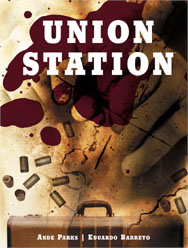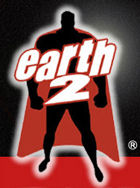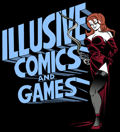| Union
Station
Why is
it that so many crime comics are set sometime in or around
the 1920s and ‘30s? I mean, Judd Winick’s Caper
had its maxi-series’ beginnings in the earlier part
of the 20th century; The Road to Perdition and subsequent
tie-ins from Max Allan Collins were Depression-Era; and Torso
from Bendis (all hail the man who writes half of Marvel’s
comics) was in the time of Elliot Ness, albeit being based
on true events he had little choice in the matter.
Maybe it’s an American obsession with
the time of cops and robbers; a time when buttonmen were
seen as often as a Starbuck’s and the only way you
knew a cop wasn’t dirty was if he was dead. For some
reason we love to tell our seedy stories near the time of
the Capones and Derringers, maybe to make the crime seem
more gentlemanly as we remember a world were gangsters sold
liquor instead of cocaine and if someone got plugged, they
probably did deserve it. I couldn’t say for sure.
But
yet again the 1930s appears in a comic about the illicit
doings of the underworld, this time in Union Station
from Oni Press.
It’s 1933 and Frank Nash is a criminal
with a past that has finally caught up with him. After being
nabbed by the Feds for some small time crime, Nash is due
to be transferred to Kansas City to start his incarceration,
but when his train gets to Union Station, a botched attempt
to free him leads to a massacre that affects the lives of
three men: FBI Agent Reed Veterlli, reporter Charles Thompson,
and underworld gun-for-hire Verne Miller.
Veterlli has to try and find a way to cope
with his mistakes made during the massacre while trying
to keep his morals intact. Verne Miller is on the run after
trying to help a friend and is closely pursued by Hoover’s
best, and Charles Thompson may find that trying to find
out what really happened at Union Station may cost him and
his family dearly.
This
is Ande Parks’ first foray into writing, having been
an inker of some renown on Green Arrow, and while
it’s clear that he has the ability to tell a story,
he needs more polish before he writes a really good one.
It’s clear that Parks has a love for the material,
being a native of Kansas and having obviously delved into
a decent amount of research on the actual Union Station
Massacre.
However,
he gets bogged down in what I can only assume is historical
detail, forgetting to really flesh out his characters in
favor of assuming the reader has some familiarity with who
these people are. The only character that he spends much
time developing is Charles Thompson, and to Parks’
credit, I found myself thoroughly interested in Thompson.
Small touches like Thompson’s easy relationship with
his son, and his utter willingness to dote on his wife when
she is still reeling from a double mastectomy (information
that Parks wisely and subtly allows the reader to discover
through the artwork and not blatant dialogue), show him
to be warm and compassionate. In several scenes, when his
family is threatened we can see the panic and fear in the
character, not just in facial expression, but in action
as well. Thompson is also the only character that gets flashbacks
to the carnage at Union Station, as well as a dream sequence
that has little to with the story, but helps to define his
relationship with his family a little better. If the comic
had focused on Thompson, it might have been a better read
as we followed only his investigation into the events of
that day.
But Parks gums up the works with the three-character
split that occurs. Vetterli and Miller are neither well
defined nor interesting enough to keep a plot thread tight.
Parks never establishes Vetterli as a very moral man early
on, other than simply mentioning that he’s Mormon,
so his moral agonizing over his survival later in the book
just sounds like whining and rings false. When Vetterli
gets pigeon-holed into knowingly accusing the wrong man
for the events of that day, his acceptance of the situation
isn’t really shocking because the character never
really went anywhere, never got down to any soul-searching
so to speak, so the reader could really give two shakes
what he does.
Verne Miller is even worse: he’s just
a thug with a gun that owed Nash a favor, and the reader
really doesn’t know what that favor is. Parks gives
him little if any characterization, so little that Parks
didn’t even deem Miller’s demise page-worthy,
as in one panel he is escaping the cops, and a few pages
later, he simply ends up dead in a photograph. The almost
pointless (and historically fuzzy) addition of Miller’s
girlfriend into the mix serves no real purpose because we
don’t even see their relationship as humanizing. He
almost seems to treat her with contempt for some reason,
not to mention they only appear together in one scene.
The artwork is good. Eduardo Barreto has
a talent for drawing the 1930s, and his very technique screams
“old school.” He shades his inks using small
dots and crosshatching that are very reminiscent of the
way comics used to be colored; the old three-color-dots
technique, and his abundant use of shadow and straight line
shading create an incredible feeling of 1930s ambience.
His characters are distinct, but only until they all don
the typical fedora and trench coat cliché, and then
it becomes extremely hard to tell what’s going on.
This was a bad, but probably historically accurate, artistic
choice. The actual massacre scene is atrociously hard to
follow, as everyone is dressed the same, and one gaping
head wound looks just like any other. This would be the
only argument for coloring this book, as some color might
help the reader differentiate between cop and crook.
Nothing
outside of Thompson’s storyline really captures the
attention, and start-to-finish, nothing much happens in
the book. There’s a massacre. There’s some feds.
There’s…not much else.
|






